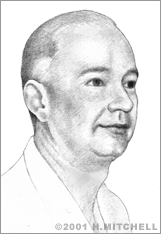Grote Reber
Grote Reber was born in Chicago on December 22, 1911. He received a bachelor’s degree from the Illinois Institute of Technology in Chicago, in 1933, where he studied radio engineering. While still a student, he became very interested in radio astronomy – in 1932 he learned about Karl Jansky's discovery of cosmic radio waves and wanted to learn more. He wondered whether the waves were coming only from the galaxy or from other celestial objects, and how the radio waves were produced.
During the 1930s Reber attempted to get a job working with Jansky, who was at Bell Labs at the time, to study cosmic radio waves. But since the economy was in a slump as the Great Depression swept over the country, the Labs weren’t hiring. So, Reber decided to study radio astronomy on his own. Meanwhile, he worked for various radio manufacturers in Chicago from 1933 to 1947.
In 1937, Reber came up with a design for a radio telescope, which he constructed in his back yard in Wheaton, Illinois, a suburb of Chicago. He built the telescope in his free time at his own expense. The telescope’s mirror was made of sheet metal 31.4 feet in diameter, and was able to focus radio waves to a point 20 feet above the dish. The telescope also featured a cylinder containing a radio receiver, which amplified the faint cosmic signals by a factor of several million. This made them strong enough to be recorded and charted. Reber knew that it would be important to observe a wide range of wavelengths of radiation from the sky in order to understand how the radiation was being produced. He achieved this by including a parabolic dish reflector in the scope, which has a shape that is usable over a wide wavelength range.
Reber spent long hours every night scanning the skies with his telescope and in 1938, he was successful in detecting radio emission from the Milky Way, confirming Jansky's earlier discovery. He later presented his data – which was essentially a survey of radio radiation from the sky. He did so using contour maps showing the brightest areas as the richest radio sources. He published the first surveys of radio waves from the sky in engineering and astronomy journals in the late 1930s and early 1940s, establishing a major field of research. Later, research groups in many countries began building bigger and better antennas and receivers to follow up on his discoveries.
Reber donated his original radio telescope to the National Radio Astronomy Observatory at Green Bank, West Virginia, and supervised its assembly there in the early 1960s. It remains there as a historical monument. In the 1950s, Reber sought a field that seemed neglected by most other researchers and turned his attention to cosmic radio waves at very low frequencies (1-2 MHz, or wavelength 150-300 meters). Waves of these frequencies cannot penetrate the Earth's ionosphere except in certain parts of the planet at times of low solar activity. One such place is Tasmania, where Reber resided until his death in 2002.
Reber worked as a Radio Physicist at the National Bureau of Standards from 1947 to 1951. From 1951 on, he has been conducting radio astronomy investigations in Hawaii and Tasmania. He was also Honorary Research Fellow of the Division of Radio Physics of the Australian Commonwealth Scientific and Industrial Research Organization. He was a member of the American Astronomical Society, and received a number of awards for his work. In 1962, he was the recipient of the Bruce gold medal of the Astronomical Society of the Pacific. In 1963, he received an Elliot Cresson gold medal from the Franklin Institute of Pennsylvania, Philadelphia. In 1976 he received the Jansky prize of the National Radio Astronomy Observatory.


